

Ag Day, 2001 One benefit of working in an academic community is exposure and interaction with diverse colleagues. I intend this statement to apply to all hierarchical levels of organization, viz., within one's own professional community around the globe where interactions focus on a common research interest, within one's institution where interactions primarily relate to the curriculum, and within one's lab, where the shared goal is to solve problems. I address the latter. The demographics of my lab associates was always in flux. For example, a snapshot of my lab (not including undergraduates) of my last year at Washington University, 1980, would have included Dr.1 Peter Minchin, a physicist from Lower Hutt, NZ with whom I shared an interest in mathematical modeling; the late Dr. Judy Croxdale from the University of Wisconsin, with whom I shared an interest in quantitative histochemistry; Prof. Dr. Gunter Kirsch of Bochum, who was interested in learning the basics of metabolite analysis; Dr. Colin Wilmer from Stirling University, a fellow stomatal physiologist; (Dr.) Peter Brown a Ph.D. student from Westchester County; and Jill Kennedy Manchester, who worked as a technician and was the step-daughter of my mentor, the late Dr. Oliver H. Lowry. A few years later, my lab was mostly American and all male (postdocs: the late Dr. Mike Harris, Dr. Chris Faraday, Dr. Liming Shen, Dr. Frank Callahan; Graduate Students: Stephan Springer and the late (Dr.) Mitchell Tarczynski). When these images were taken, my lab comprised four graduate students, all young, female and three of them Chinese nationals. All four of my 2001 graduate students had entered graduate academics through the traditional route, and, though plant biologists, had little or no experience with applied plant biology, i.e., farming. To "remedy" this situation, I led them on a one-day field trip that included Production Agriculture (a tobacco sales warehouse in Moultrie, GA, and my farm where cotton was being grown) and Historic (primitive) Agriculture (then known as the Agrirama, Tifton, GA). It was a fun and interesting day for all of us, I think, and I share images.
|
|
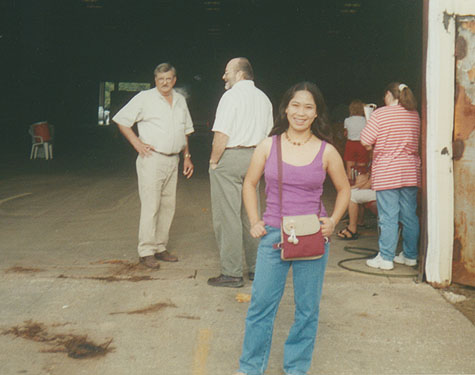 |
|
| In the left image, Tianran Jiang poses outside the tobacco warehouse and I am standing in the doorway. Tianran entered our program as a doctoral student, but changed her goal to a joint Mrs.-M.S. degree. That is, she met a husband and moved out of country with him, thus truncating her studies. I hasten to add, however, that her thesis was masterful, no pun, and I deeply regret that I did not bring it to publication. She conducted a study designed to understand the interaction of extracellular malate on an external guard-cell receptor(s) in the closing response. At right, I stand with my hand on a tobacco pile, and Tianran faces the camera again. (Dr.) Yun Kang, nka Stacy Kang, stands in front of me. When Yun joined the lab, we had discovered that the accumulation of sucrose in the guard-cell wall diminished stomatal aperture size, providing a fine-control mechanism to tie the rates of photosynthesis, of transpiration, and of translocation together. Our previous work had used apoplastic phloem loaders, and Yun's publications demonstrated that this effect was absent in symplastic phloem loaders. At this writing, she opted to stay in the U.S. and is a research scientist. | |
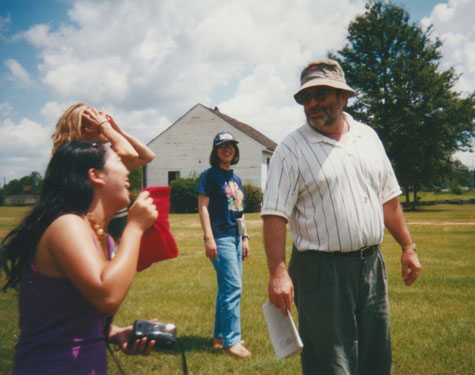 |
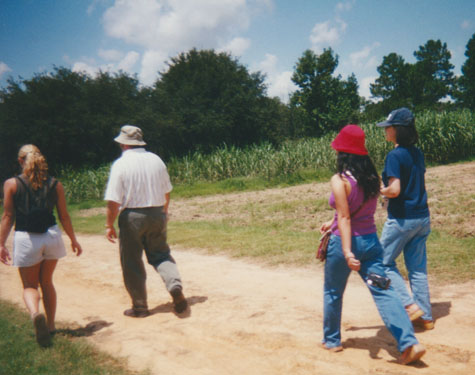 |
At left, Tianran finds abundant humor in something in a walk at the Agrirama. Meanwhile, (Dr.) Fanxia Meng (wearing cap in background) only finds it mildly amusing. Fanxia studied the accumulation of the stress hormone, ABA, in guard cells under a number of conditions. To do so, she used a powerful ELISA (10-16 mol) that we developed with a German lab 10 years earlier. Fanxia completed her Ph.D. and returned to China with her husband, who had secured a prominent position there. Here, Fanxia is shown in Beijing with her husband, Long, her baby, and Prof. Shuqiu Zhang, Fanxia's M.S. advisor at the Chinese Agricultural University and my long-time colleague. At right, (Dr.) Danielle Sherdan walks at my left. Danielle was a home-grown student, who had made record-breaking progress with her undergraduate degree, having attended community college as a high-school student before entering FSU. Soon after joining FSU, she took a course with me and realized she had a special interest in plants. From then on, she was a fixture in my laboratory, all the way through to her Ph.D. (Her family joked that I was her "Tallahassee Daddy.") She had a strong interest in teaching--with awards and publications to show it--and found employment in an FSU science-teaching institution headed by a Nobel laureate. |
|
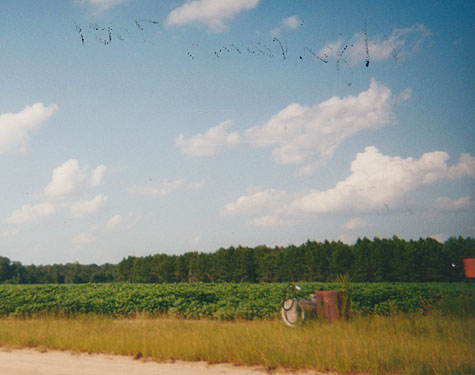 |
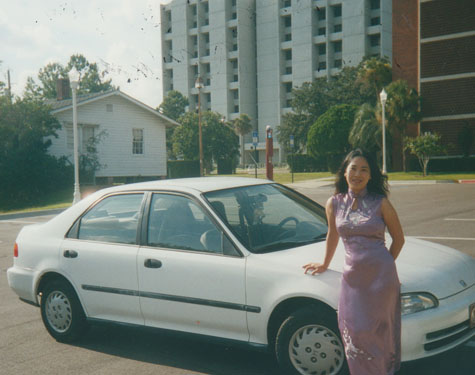 |
At left, note the cotton growing on the only cultivated land that I inherited from the Watson side. This image is taken from Grandpa's front yard and the clear area in the foreground is the Mark Watson Road. Also, note the well, which stands as a memorial to the last mule, Cora (in earlier times, that area was occupied by several buildings--a cow barn, a mule barn and yard, two pack houses, a vehicle shelter). At the time of our "field trip," Mama's brother Herbert tended all the original Mark Watson Farm, the Grandma Place, and our farm. I shortly afterwards started operating the farm myself and took this field out of cultivation so the agrichemicals could dissipate. In 2006, it was planted in longleaf pines (photo 2012-04-15). At right is another photo of Tianran, though not taken the day of our field trip. We rounded the day off with dinner at Ray's Mill Pond, when my greatgrandfather Mitchell N. Fountain was the miller. Though the Chinese "eat everything," none of these young students had had alligator before, thus adding a new experience. |
|
Footnote 1. "Dr." indicates the title at the time this essay referred to. "(Dr.)" indicates that the title was subsequently earned. Last edit 2012-08-11. |
|
Return to Documentation for this page. |
|